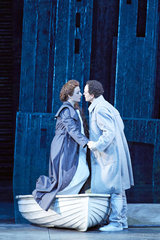| Opera Reviews | 19 April 2024 |
The Vienna State Opera's new Pelléas is strongly etchedby Moore Parker |
|
| Debussy: Pelléas et Mélisande Vienna State Opera 27 June 2017 |
|
|
An ambitious stage-filling set comprising blue-grey distressed surfaces dotted with nooks, crannies and niches, multiple access points, and a large corrugated-iron shutter centre stage (for the finale) serves throughout. While spacious, little sense of distance or variety is achieved - rather compacting the various scenes into a claustrophobic space, which in a certain sphere more reflects the psyche of the protagonists than the action in which they indulge. Water is essentially omnipresent - alone in the form of an enormous basin of some 12,000 litres, through which the protagonists wade and row - but also in opaque mists and cleverly designated rain showers, in addition to decorating the drops linking the on-going tableaux. Significant too is an ever-present, multi-functional, rowing-boat - ingeniously employed by Marelli to underscore or elucidate a scene and its relevant dramatic aspect. Variable wooden walkways can present issues - with Pelléas, in particular, appearing to negotiate his crossings very gingerly. The structured set sees various tableaux imposed upon it - some less successfully than others (in particular the Act III Scene 2 vaults) - but others wonderfully atmospheric, such as the finale in which Mélisande’s soul (still in corporeal shroud) glides through the central rear aperture into the sunlight, her salvation expressed through the only moment of warm-toned lighting in the evening. In addition to direction and set design, Marco Arturo Marelli is responsible for lighting, which - while often atmospheric - might have been more imaginative at times. Possibly the most remarkable creation of the evening is Maria Nazarova’s Yniold. The pretty coloratura soprano is here transformed into an absolutely convincing pre-pubescent boy - vocally, and in a gamut of gripping physically-explosive emotion and action. The character is woven between the protagonists throughout the drama - who otherwise remain starkly isolated despite their interaction. The final curtain drops as Yniold saves Golaud, who has cocked his shotgun at his own throat in despair. Golaud is indeed Simon Keenlyside’s Rigoletto! This is truly the English baritone’s Fach, and his unforced, pristine, vocalism was a joy throughout. The figure is broodingly intense and winning in sympathy, long in advance of his remorse in the the final scene. Pelléas (less Golaud’s junior than often depicted) contrasts in his coy - at times almost epicene - diffidence. His bond with Mélisande is somehow apocalyptic rather than virile in nature. Ideally cast, Adrian Eröd well-utilizes his light, heady, baritone to negotiate the role’s baritenor range with finesse and aplomb. Olga Bezsmertna sings Mélisande exquisitely, displaying the lightness of approach required while encompassing the warmth and fullness throughout her range that lower-lying voices (von Stade being a prime example) have previously enjoyed. Costumed in white, with virtually floor-touching tresses, the figure is statuesque (almost a Daphne or Ariadne) - arguably too glamorously made-up, and somewhat lacking the youthful vulnerability to provide ideal contrast as the character moves through the drama. Towering in stature and tone, Franz-Josef Selig’s Arkel ranks with the finest, and contrasts with Bernarda Fink’s modest-toned Geneviève, who (while warm and cultivated) consequently appears much subservient alongside her spouse’s dominant utterances. The cast was complimented by Markus Pelz’s Doctor, and Andreas Bettinger as Pelléas’ Father. Alain Altinoglu could be accused of having a love affair with Debussy’s score, drawing superb playing from the State Opera Orchestra while endowing the drama with the finest of detail and precision. The production returns in October - oddly, with a new conductor and with Simon Keenlyside as the only leading member from this
|
|
| Text ©
Moore Parker Photo © Wiener Staatsoper / Michael Pöhn |

 This is an extraordinary production - and one to crown the season as the latest addition to the company’s stable.
This is an extraordinary production - and one to crown the season as the latest addition to the company’s stable.





